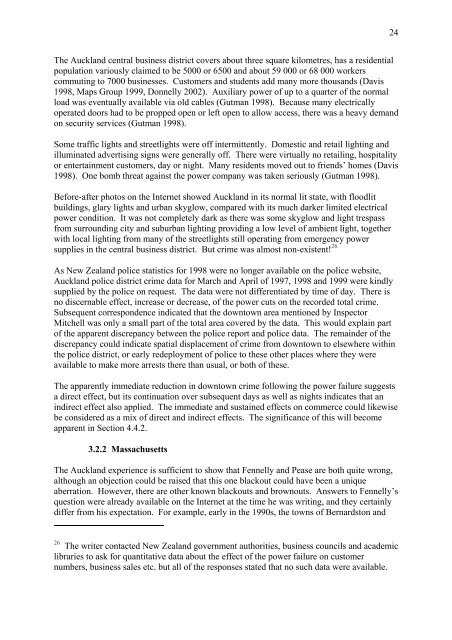Outdoor Lighting and Crime - Amper
Outdoor Lighting and Crime - Amper
Outdoor Lighting and Crime - Amper
Create successful ePaper yourself
Turn your PDF publications into a flip-book with our unique Google optimized e-Paper software.
The Auckl<strong>and</strong> central business district covers about three square kilometres, has a residential<br />
population variously claimed to be 5000 or 6500 <strong>and</strong> about 59 000 or 68 000 workers<br />
commuting to 7000 businesses. Customers <strong>and</strong> students add many more thous<strong>and</strong>s (Davis<br />
1998, Maps Group 1999, Donnelly 2002). Auxiliary power of up to a quarter of the normal<br />
load was eventually available via old cables (Gutman 1998). Because many electrically<br />
operated doors had to be propped open or left open to allow access, there was a heavy dem<strong>and</strong><br />
on security services (Gutman 1998).<br />
Some traffic lights <strong>and</strong> streetlights were off intermittently. Domestic <strong>and</strong> retail lighting <strong>and</strong><br />
illuminated advertising signs were generally off. There were virtually no retailing, hospitality<br />
or entertainment customers, day or night. Many residents moved out to friends’ homes (Davis<br />
1998). One bomb threat against the power company was taken seriously (Gutman 1998).<br />
Before-after photos on the Internet showed Auckl<strong>and</strong> in its normal lit state, with floodlit<br />
buildings, glary lights <strong>and</strong> urban skyglow, compared with its much darker limited electrical<br />
power condition. It was not completely dark as there was some skyglow <strong>and</strong> light trespass<br />
from surrounding city <strong>and</strong> suburban lighting providing a low level of ambient light, together<br />
with local lighting from many of the streetlights still operating from emergency power<br />
supplies in the central business district. But crime was almost non-existent! 26<br />
As New Zeal<strong>and</strong> police statistics for 1998 were no longer available on the police website,<br />
Auckl<strong>and</strong> police district crime data for March <strong>and</strong> April of 1997, 1998 <strong>and</strong> 1999 were kindly<br />
supplied by the police on request. The data were not differentiated by time of day. There is<br />
no discernable effect, increase or decrease, of the power cuts on the recorded total crime.<br />
Subsequent correspondence indicated that the downtown area mentioned by Inspector<br />
Mitchell was only a small part of the total area covered by the data. This would explain part<br />
of the apparent discrepancy between the police report <strong>and</strong> police data. The remainder of the<br />
discrepancy could indicate spatial displacement of crime from downtown to elsewhere within<br />
the police district, or early redeployment of police to these other places where they were<br />
available to make more arrests there than usual, or both of these.<br />
The apparently immediate reduction in downtown crime following the power failure suggests<br />
a direct effect, but its continuation over subsequent days as well as nights indicates that an<br />
indirect effect also applied. The immediate <strong>and</strong> sustained effects on commerce could likewise<br />
be considered as a mix of direct <strong>and</strong> indirect effects. The significance of this will become<br />
apparent in Section 4.4.2.<br />
3.2.2 Massachusetts<br />
The Auckl<strong>and</strong> experience is sufficient to show that Fennelly <strong>and</strong> Pease are both quite wrong,<br />
although an objection could be raised that this one blackout could have been a unique<br />
aberration. However, there are other known blackouts <strong>and</strong> brownouts. Answers to Fennelly’s<br />
question were already available on the Internet at the time he was writing, <strong>and</strong> they certainly<br />
differ from his expectation. For example, early in the 1990s, the towns of Bernardston <strong>and</strong><br />
26 The writer contacted New Zeal<strong>and</strong> government authorities, business councils <strong>and</strong> academic<br />
libraries to ask for quantitative data about the effect of the power failure on customer<br />
numbers, business sales etc. but all of the responses stated that no such data were available.<br />
24
















